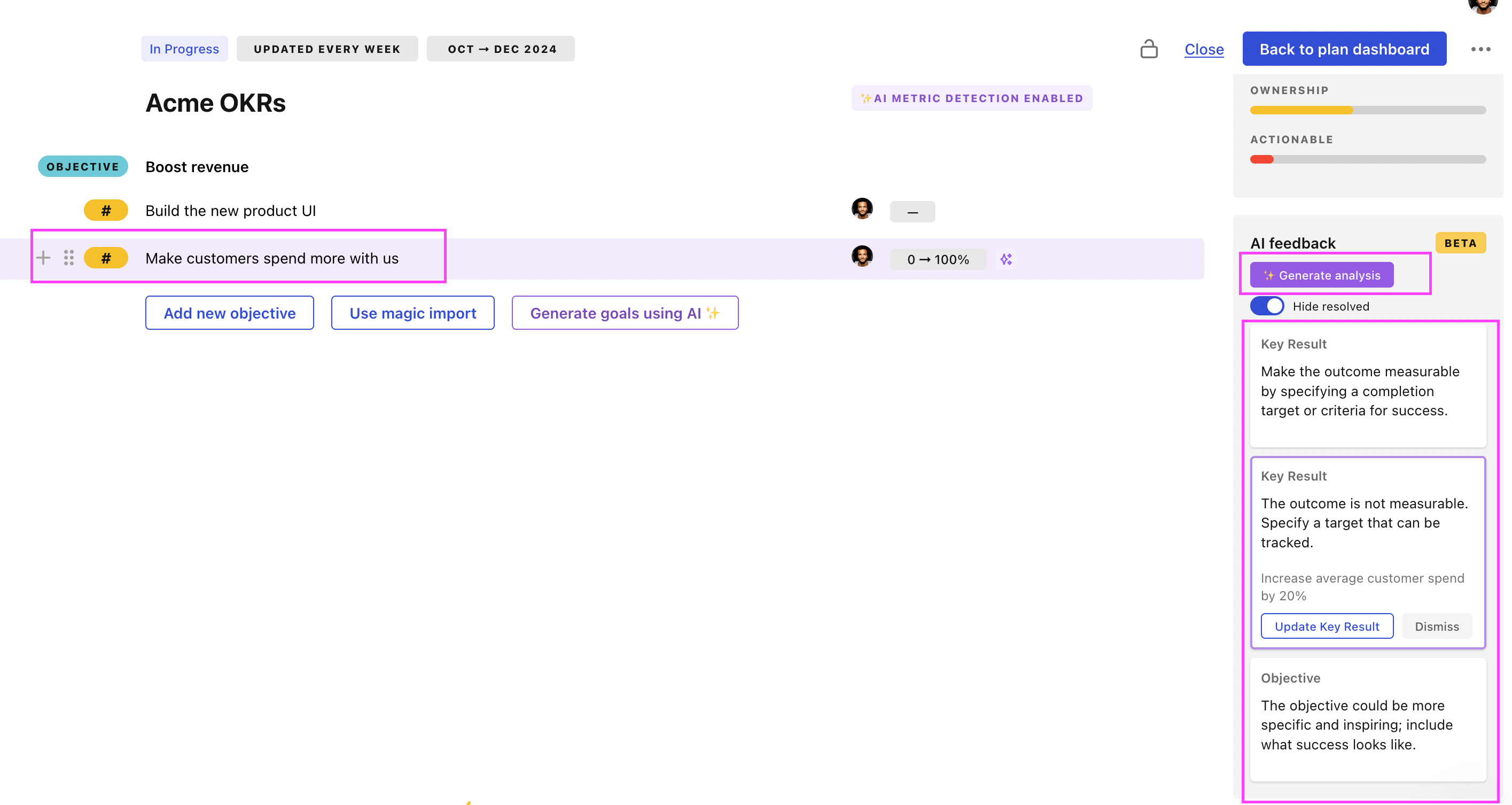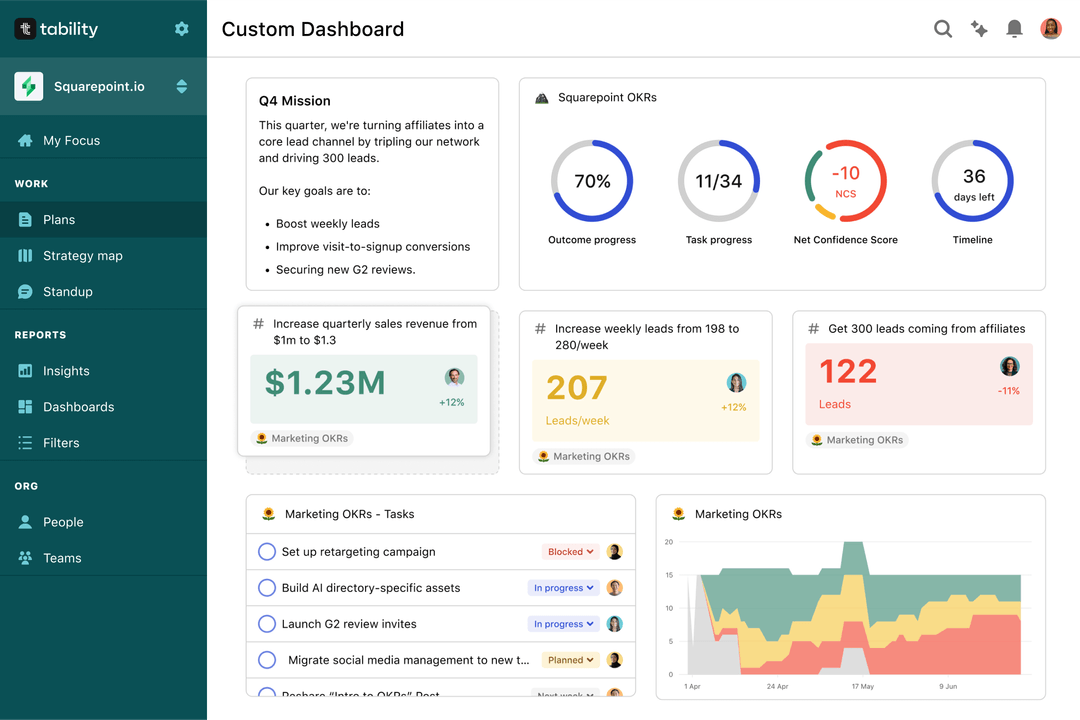Tability is a cheatcode for goal-driven teams. Set perfect OKRs with AI, stay focused on the work that matters.
What are Incident Response Coordinator OKRs?
The OKR acronym stands for Objectives and Key Results. It's a goal-setting framework that was introduced at Intel by Andy Grove in the 70s, and it became popular after John Doerr introduced it to Google in the 90s. OKRs helps teams has a shared language to set ambitious goals and track progress towards them.
Formulating strong OKRs can be a complex endeavor, particularly for first-timers. Prioritizing outcomes over projects is crucial when developing your plans.
We've tailored a list of OKRs examples for Incident Response Coordinator to help you. You can look at any of the templates below to get some inspiration for your own goals.
If you want to learn more about the framework, you can read our OKR guide online.
The best tools for writing perfect Incident Response Coordinator OKRs
Here are 2 tools that can help you draft your OKRs in no time.
Tability AI: to generate OKRs based on a prompt
Tability AI allows you to describe your goals in a prompt, and generate a fully editable OKR template in seconds.
- 1. Create a Tability account
- 2. Click on the Generate goals using AI
- 3. Describe your goals in a prompt
- 4. Get your fully editable OKR template
- 5. Publish to start tracking progress and get automated OKR dashboards
Watch the video below to see it in action 👇
Tability Feedback: to improve existing OKRs
You can use Tability's AI feedback to improve your OKRs if you already have existing goals.
- 1. Create your Tability account
- 2. Add your existing OKRs (you can import them from a spreadsheet)
- 3. Click on Generate analysis
- 4. Review the suggestions and decide to accept or dismiss them
- 5. Publish to start tracking progress and get automated OKR dashboards

Tability will scan your OKRs and offer different suggestions to improve them. This can range from a small rewrite of a statement to make it clearer to a complete rewrite of the entire OKR.
Incident Response Coordinator OKRs examples
You'll find below a list of Objectives and Key Results templates for Incident Response Coordinator. We also included strategic projects for each template to make it easier to understand the difference between key results and projects.
Hope you'll find this helpful!
OKRs to improve efficiency of incident response
ObjectiveImprove efficiency of incident response
KRDecrease median incident respond time by 30%
Enhance team training on rapid response protocols
Implement a prioritization system for assessing incidents
Invest in automated incident handling tools
KRImplement new training to decrease initial reaction time by 20%
Identify current weak points in reaction time training
Collaborate with experts to develop effective training methods
Introduce new training program to staff
KRIncrease the resolution rate of first responses by 25%
Update and upgrade customer service software tools
Review and refine existing support protocols
Implement ongoing training programs for customer service representatives
OKRs to improve and Optimize Incident Response
ObjectiveImprove and Optimize Incident Response
KRIncrease incident response speed by 30% to reduce downtime
Implement automated incident detection software
Train staff on efficient response protocols
Develop a streamlined incident escalation process
KRTrain all team members on incident response protocols and breach simulations
Simulate potential breach scenarios for practice
Organize incident response protocol training for all team members
Follow-up with tests to assess team's knowledge and readiness
KRImplement at least two innovative incident management tools for better response
Train staff on usage and implementation of tools
Choose two tools that best suit our needs
Research latest innovative incident management tools
OKRs to enhance effectiveness of response processes for security incidents
ObjectiveEnhance effectiveness of response processes for security incidents
KRReduce average incident response time by 30%
Implement automated incident response software
Review and streamline incident report process
Enhance training of response team
KRConduct simulation exercises post-training to achieve at least 80% success rate
Monitor and measure success rates, aiming for 80% achievement
Implement simulation exercises regularly for all trained individuals
Develop a variety of simulation exercises relevant to the training content
KRImplement incident response training for 100% of the security team
Identify key incident response topics for comprehensive training
Develop interactive, practical training modules for the team
Schedule and conduct training sessions regularly
OKRs to streamline maintenance request and incident handling process
ObjectiveStreamline maintenance request and incident handling process
KRReduce response times to maintenance requests by 15%
Schedule regular preventive maintenance checks
Train staff in effective, efficient problem resolution
Implement a prioritized ticketing system for maintenance requests
KRDecrease incident closure times by 20%
Implement streamlined incident management processes
Train staff on efficient incident resolution techniques
Monitor and evaluate performance regularly
KRImprove customer satisfaction rate regarding handled incidents by 10%
Implement customer feedback surveys after incident resolution
Streamline incident response procedure
Provide staff with customer service training
OKRs to enhance efficiency and effectiveness of incident management
ObjectiveEnhance efficiency and effectiveness of incident management
KRImplement staff training for incident resolution, achieving a 90% completion rate
Identify necessary skills for incident resolution
Monitor and track staff completion rates
Develop a comprehensive training module
KRIncrease the rate of successful incident closures by 40%
Incorporate technology solutions for incident tracking
Implement robust training programs for incident response teams
Enhance incident management processes for efficiency
KRReduce incident response time by 35%
Define standard incident response protocols
Conduct regular response time training simulations
Implement efficient incident management software
OKRs to implement comprehensive security training for all staff
ObjectiveImplement comprehensive security training for all staff
KRSuccessfully train 90% of staff through the newly launched security program
Schedule and implement regular training sessions
Develop concise, engaging materials for staff training
Identify key individuals for initial pilot of security program training
KRDevelop a detailed security training curriculum by engaging external consultants
Collaborate on curriculum details and learning objectives
Initiate a contract with chosen security consultant team
Identify reputable external consultants in security training development
KRAssess training effectiveness by improving security incident response time by 25%
Develop a benchmark for current security incident response times
Monitor and evaluate post-training response times
Implement advanced training techniques to improve reaction times
Incident Response Coordinator OKR best practices
Generally speaking, your objectives should be ambitious yet achievable, and your key results should be measurable and time-bound (using the SMART framework can be helpful). It is also recommended to list strategic initiatives under your key results, as it'll help you avoid the common mistake of listing projects in your KRs.
Here are a couple of best practices extracted from our OKR implementation guide 👇
Tip #1: Limit the number of key results
Having too many OKRs is the #1 mistake that teams make when adopting the framework. The problem with tracking too many competing goals is that it will be hard for your team to know what really matters.
We recommend having 3-4 objectives, and 3-4 key results per objective. A platform like Tability can run audits on your data to help you identify the plans that have too many goals.
Tip #2: Commit to weekly OKR check-ins
Setting good goals can be challenging, but without regular check-ins, your team will struggle to make progress. We recommend that you track your OKRs weekly to get the full benefits from the framework.
Being able to see trends for your key results will also keep yourself honest.
Tip #3: No more than 2 yellow statuses in a row
Yes, this is another tip for goal-tracking instead of goal-setting (but you'll get plenty of OKR examples above). But, once you have your goals defined, it will be your ability to keep the right sense of urgency that will make the difference.
As a rule of thumb, it's best to avoid having more than 2 yellow/at risk statuses in a row.
Make a call on the 3rd update. You should be either back on track, or off track. This sounds harsh but it's the best way to signal risks early enough to fix things.
Save hours with automated Incident Response Coordinator OKR dashboards

OKRs without regular progress updates are just KPIs. You'll need to update progress on your OKRs every week to get the full benefits from the framework. Reviewing progress periodically has several advantages:
- It brings the goals back to the top of the mind
- It will highlight poorly set OKRs
- It will surface execution risks
- It improves transparency and accountability
Most teams should start with a spreadsheet if they're using OKRs for the first time. Then, you can move to Tability to save time with automated OKR dashboards, data connectors, and actionable insights.
How to get Tability dashboards:
- 1. Create a Tability account
- 2. Use the importers to add your OKRs (works with any spreadsheet or doc)
- 3. Publish your OKR plan
That's it! Tability will instantly get access to 10+ dashboards to monitor progress, visualise trends, and identify risks early.
More Incident Response Coordinator OKR templates
We have more templates to help you draft your team goals and OKRs.
OKRs to enhance platform usability for heightened customer satisfaction and retention
OKRs to enhance accuracy and swiftness in timesheets processing
OKRs to implement green energy solutions for branch cost-cutting and eco-friendliness
OKRs to streamline and optimize global hiring processes
OKRs to minimize escalation cases in customer service
OKRs to to streamline management of tasks and day-to-day responsibilities